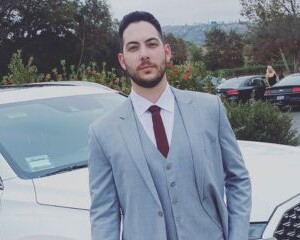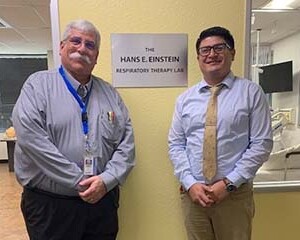Rancho Cordova Respiratory Therapy students jump in to aid Paradise fire evacuees
Recently a faculty member and several students from SJVC Rancho Cordova’s Respiratory Therapy program ran toward danger to help the members of the town destroyed by California’s deadly and devastating Camp Fire.
Residents of Paradise took refuge in a make-shift medical shelter set up in Chico, which is about 45 minutes away from their hometown. San Joaquin Valley College’s Respiratory Therapy team was part of over 40 volunteers who put their own health at risk to be of medical and emotional support to the survivors.
Ajaypal (Ajay) Randhawa, who graduated from SJVC’s Respiratory Therapy program and is currently working as a clinical instructor for the college in addition to working for Adventist Health in Marysville, was first to recognize the opportunity to help the community. He put the call out to his students to join him in a volunteer effort to help those temporarily encamped at the medical shelter in Chico.
“I wanted them to know the gravity of the situation…the unhealthy air, other risks and the emotion of being with patients who were unhealthy from smoke that would cause them to be really, really sick,” says Ajay. “It would also be difficult for them to see so many people hurting physically and emotionally.”
One hundred percent of the students he invited to volunteer for this “mass surge” event wanted to be on those front lines. They made their way to the site.
“This was the most humbling [thing] I have ever experienced,” says Callie Williams, an SJVC Respiratory Therapy student who volunteered at the Chico medical shelter. “We went to the shelter to access these displaced individuals for respiratory issues. A major part of this experience was just talking to these individuals and listening to their stories. Seeing the look of the unknown on their faces was heartbreaking. Lives were lost, material items and their homes are no longer there. For some, their city is gone.”
The medical shelter was set up on a dirt lot and reflected the chaotic nature of something hastily assembled. Ajay never met the person in charge, but that didn’t deter him from his sense of responsibility to his team and to those they would help. After a volunteer gave them a brief overview of what kinds of services were being provided to the evacuees, he and his team went straight to work.
“We knew we were dealing with a lot of COPD (Chronic Obstructive Pulmonary Disease) patients who were dependent on oxygen and whose condition was exacerbated by smoke they had inhaled,” says Ajay. “A lot of them didn’t have their nebulizers because they had left in a hurry and got out with minimal possessions.”
Respiratory volunteers had instructions as to the limits of what they could provide. “We assessed every single person, used a stethoscope to listen to lung sounds, checked oxygen levels through a handheld device, measured their breaths per minute and made sure they were coherent,” says Ajay. If needed, the patients would be taken to a more isolated area for further care.
A variety of medical supplies materialized, donated from local hospitals, so a triage area was set up to administer some level of treatment. Some medications were available, but several without the necessary apparatus for administering them. There was a mini air compressor available, which made it possible to provide breathing treatments.
“We were so used to assessing patients in a clinical environment where we know where things are,” says Marina Serman, Respiratory Therapy program student. “Out in the real world, it was different. We had to rely on our skill set to complete an assessment. Ajay was there every step of the way, teaching us techniques on every aspect of the process. Most of the people in the shelter needed emotional support, so we just listened to them vent and held their hand.”
Holding a hand in need requires empathy, professionalism and patience. And even those service providers were in short supply.
“There weren’t enough respiratory volunteers, so I made a Facebook post the night before, showing people how to volunteer, and hoped they’d take the initiative,” says Ajay.
There was an outpouring of goodwill. “Friends, colleagues in the field, co-workers, people I went to school with started asking questions,” says Ajay. “A network was established of people who wanted to come as soon as they found out it was safe to come there.”
Tyler Lawrence, an SJVC Respiratory Therapy program graduate who was working at Sutter General Hospital in Sacramento, was one of those who answered the call. “He drove about 2 hours each way,” says Ajay. “He’d seen my Facebook post and wanted to help. He was the only other Respiratory Therapist to arrive for the night, and he kept an eye on the patients we were worried about.”
He was not the only one who made the 2-plus hour commute, even as the fire defied containment and at one point threatened to point toward Chico.
Safety could not be guaranteed. “My clinical group and I got in one car and drove up to the shelter,” says Mark Kindyuk, Respiratory Therapy student volunteer. “On our way there, the air quality was slowly getting worse and worse until at one point it seemed as if we were in a dense fog. But it wasn’t fog, it was smoke. I saw fields of grass burned to a crisp. The oncoming traffic consisted of a lot of fire trucks and their crew. That’s when the gravity of the whole situation sank in.”
The scene at the medical shelter was not encouraging. “There were supplies scattered everywhere, from crates of water bottles to mounds of clothes for the needy,” says Mark. This did not resemble the environment in which he imagined he might most effectively serve his patients.
“There were so many people everywhere, lined up sleeping on air mattresses, old sofas, recliners and cots inside of a church gym,” says Jenna Jones, one of Ajay’s students who answered the call to provide respiratory care. “Not to mention the city of tents in the backyard of the shelter,” she says. “People were sleeping in their cars in the parking lot and all the animals were in a room, just sleeping in their kennels.”
Volunteers looked past the chaos, the disorganization, pain and loss in hopes of providing some measure of refuge, physical relief and emotional stability. “Going to the shelter made me feel worthy and like I can actually help,” says Jenna.
The volunteers found they could work around any given obstacle. “One evacuee had sleep apnea and didn’t have his machine, which he absolutely needs at night,” says Ajay. “We had to set him up with a bariatric bed to help him sleep at a 45-degree angle.”
Ajay took full charge of his team of Respiratory Therapy student volunteers. “I stressed hand hygiene and masks for the students and made sure nothing was conducted without me knowing,” he says. “They were instructed to assess patients and come back to me with any concerns. Any time a learning opportunity would present itself, I would get the students together and go over it with them.”
“Ajay (our preceptor) did an excellent job of delegating and organizing our roles so that we could move thoroughly and effectively,” says Mark. “We set up a SVN (small volume nebulizer) treatment station near the nursing section and assessed our patients to see who was in need of a treatment.”
This crisis provided a crash course in administering the most effective care possible in the direst of circumstances. Students came away with an education that cannot be absorbed from a textbook or lecture.
“I have sharpened my assessment skills, I am more confident when approaching a new patient and introducing myself, I am now better at charting the information I find on my patient, and I have a better understanding about how important teamwork is among nurses and respiratory therapists,” says Mark. “I have a better appreciation for volunteers, I see the importance of listening to a patient talk about what they went through, I am better at time management and I realize how much I enjoy helping people.”
Becoming the human buffer between people and their physical and personal tragedy is a calling too few answer with their career choice.
“The whole reason I chose to be a respiratory therapist was that I wanted to help people,” says Jenna. “Going to the shelter was a reminder of why I’m doing this.”
Their instructor knows his students’ hearts, minds and capabilities. “I feel it’s important when events like this occur, that we have to go to the basics of our training and look past the emotional aspect of it,” says Ajay. “We find ways to treat patients to make them feel better from the inside. It’s more about being a human than being a health care provider. Emotional support is also an important component of treatment.”
You might also like
More stories about
Request Information
All fields using an asterik (*) are required.


